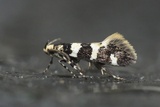Denisia albimaculea (Haworth, 1828) Species
Last modified: Dec. 8, 2025, 5:49 p.m.
Used to be a widespread but rarely observed species in Belgium, nowadays still a very rare species. Since 1980 only recorded in Flanders and HA. Could be misidentified as Denisia augustella.
Details
- Classification
- Family: Oecophoridae > Subfamily: Oecophorinae > Genus: Denisia > Species: Denisia albimaculea
- Vernacular names
- Wit stamgastje (NL)
- First mention in Belgium
- Dufrane A. 1930. Microlépidoptères nouveaux pour la faune belge. — Lambillionea 30: 158–161. On page 161.
- Status
-
Native
Distribution
Caterpillar
Greyish white, head capsule and prothoracic plate reddish brown.
Bionomics
Not much is known with certainty on the biology of this species because of its similarity with other Denisia species.
The egg is probably laid in crevices on tree bark.
The larva spins a silken tube from which it feeds on the surrounding fungi. The tube is usually hidden behind old bark.
Pupates in a silken frass-covered cocoon in the larval habitation during April–May.
The adults are sometimes found resting on tree trunks during daytime, later they come to light.
Flight periods
The adults fly in a single generation a year from early May till June.
Observed on
- Substrates:
- Fungi
The larva lives under dead bark, in decayed wood, and amongst other plant material from conifers like Larix and also on deciduous trees like Aesculus and Ulmus.
Habitat
Deciduous or mixed forests with old trees.

